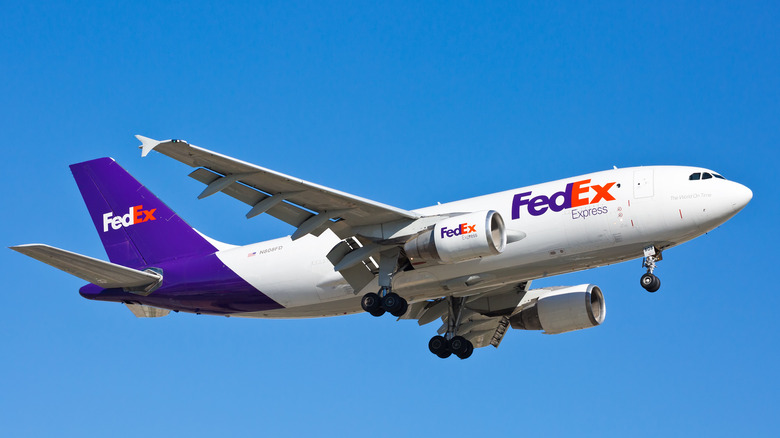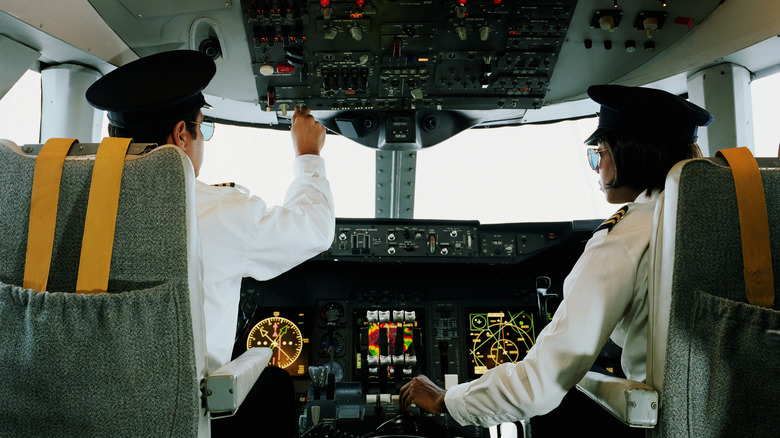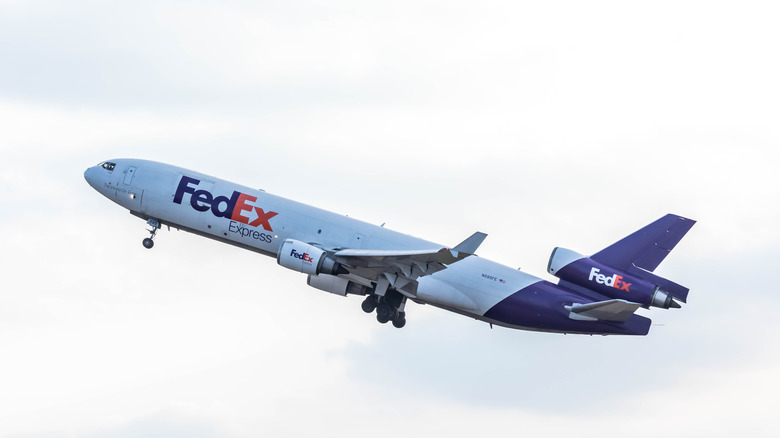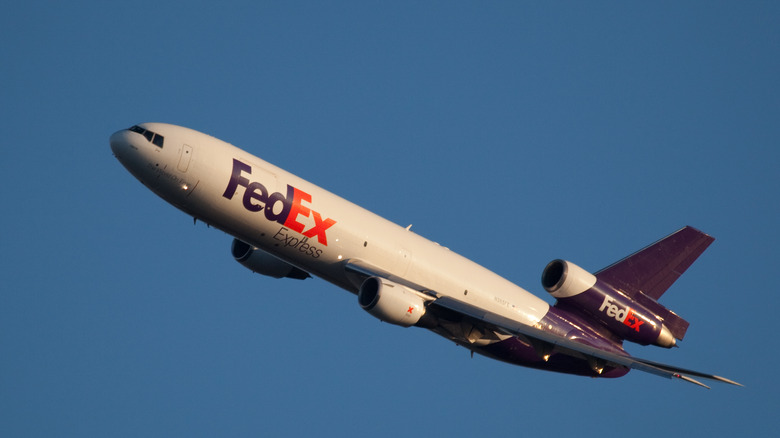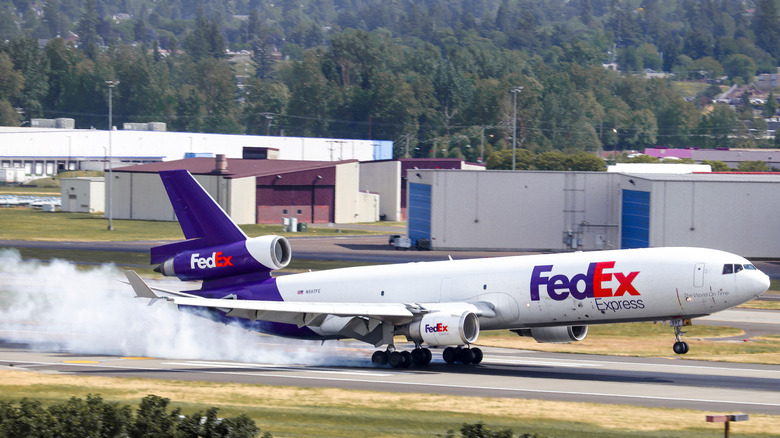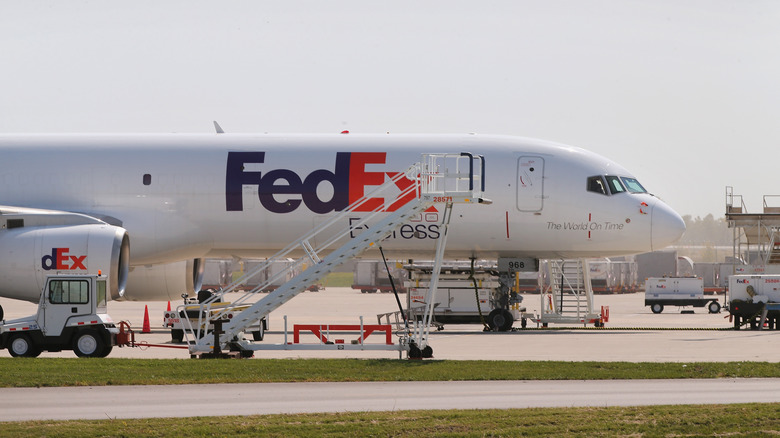The Harrowing 1994 Hijacking Of FedEx Flight 705 Explained
On April 7, 1994, a FedEx flight took off with just four flight crew members and cargo comprised of mail and packages. Three of the flight crew were pilots, and a last-minute addition was a non-revenue passenger who had previously flown in the U.S. Navy. Because of the small number of people on board and the routine route from Memphis to San Jose, the flight did not seem like it would be particularly eventful. However, FedEx flight 705 ended up being a story of hijacking almost stranger than fiction.
Unknown to the three pilots — David Sanders, first officer James Tucker Jr., and flight engineer Andre Peterson — the fourth man on board had a dark ulterior motive for going on the trip. Auburn Calloway, a FedEx flight engineer on a ferry flight, was dealing with severe financial issues following his divorce; worse, he was facing an inquiry at FedEx for potentially lying about his flight hours, according to History Daily. If Calloway were to be found guilty of manipulating his hours, he would have likely been fired and blacklisted from his occupation.
Faced with these issues, Calloway decided he would sabotage the flight by making it look like an accidental crash — allowing his children to claim his life insurance, which totaled over $2 million. Little did he know that the three pilots on board were prepared to give the fight of their lives.
The mysterious 'issues' before the flight
Ironically, though, there weren't supposed to be three pilots on the originally scheduled flight. According to History Daily, the crew for flight 705 was originally comprised of one man and one woman — which would have made Auburn Calloway's plan to overpower the crew much easier to accomplish. However, flight regulations mandate a maximum number of minutes worked at a time, and the original duo surpassed that maximum by a single minute, meaning a new crew had to take over.
But even though the new team consisted of three men in their 30s and 40s, Calloway was not put off from the job. After all, he had a number of weapons concealed in a guitar case, including two claw hammers, two club hammers, a knife, and a speargun. From his time in the Navy, Calloway knew how to attack a body to make the wounds consistent with the blunt force trauma that would come from a plane crash. He also made sure to disable the cockpit recorder before the flight to leave no trace of his plot.
Luckily, during pre-check procedures, flight engineer Andre Peterson noticed it was off and reset the program. He then went to continue on the plane's exterior. When he returned to the cockpit, he noticed it had been turned off yet again, per X Pilot. Peterson turned it on once more.
Flight 705 takes to the skies
Despite the oddness with the cockpit voice recorder, the flight took off as scheduled, with James Tucker Jr. in control as the primary pilot. However, once the plane hit 18,000 feet in altitude, Auburn Calloway took out his weapons and struck Andre Peterson in the head multiple times with one of his club hammers (via X Pilot). It also happened so quickly that Tucker did not realize what was happening until he, too, was hit by Calloway. Their injuries were so severe that bone fragments were lodged into their brains. At this point, the remaining crew member, David Sanders, attempted to fight off Calloway but was also hit with the hammer.
Sanders later recalled the violent incident in a speech, as recorded by the State Aviation Journal. "I heard a strange metallic sound from the back where the bad guy went. I turned to my right to see him holding a 20-ounce framing hammer which he used to hit me in the head three times," he stated. However, the pilot was not ready to give up, forcing Calloway to get his other weapons. "Later, dazed, I tried to get out of my seat belt to confront him," Sanders added. "He was standing in the doorway with the loaded spear gun. He said, 'Get back in your seat. This is a real gun and I will kill you!'"
The frantic fight continues
But the men were not ready to give up. According to X Pilot, Andre Peterson, though gravely wounded, managed to grab the spear gun's tip and tried the wrestle the weapon away from Auburn Calloway. David Sanders, meanwhile, tried to fight off Calloway. However, it was a difficult task — Sanders had been seriously wounded, and Calloway was a trained martial artist who had prepared for a scuffle.
Meanwhile, James Tucker Jr. was trying to maintain control of the plane. However, the injuries to his skull were slowly paralyzing the right side of his body. In an attempt to injure Calloway, Tucker decided to maneuver the plane as haphazardly as possible. To do this, he pulled the plane's yoke to the left, making it spiral into a barrel roll at around 400 miles per hour (per Tail Strike). The plane had not been designed for this action and was a major risk; however, Tucker clearly decided that Calloway was the bigger threat.
As a result of the aerial acrobatics, Sanders, Peterson, and Calloway were tossed around the cockpit and galley, at times feeling weightless and fighting on the ceiling. Sometimes, they felt the pressure of three times their weight in gravity forces as the plane turned.
Things get even more hectic
The plane's maneuverings helped David Sanders and Andre Peterson pin down Auburn Calloway at long last, and James Tucker Jr. managed to radio for help and express his plan to return to Memphis (via "May Day: Air Disaster"). However, Sanders and Peterson were progressively getting weaker due to their blood loss. Because of this, they called on Tucker Jr. to help them restrain Calloway. Tucker tried to engage the auto-pilot, but because of the plane's instability, it failed. Nevertheless, Tucker decided to leave the cockpit to help his two comrades, leaving no one to fly the plane.
But when Tucker left, Memphis Radio Control attempted to contact him. Receiving no response, they believed that the plane had been successfully hijacked and therefore did not radio when the plane appeared to move further and further away from the airport. Sanders eventually returned to the cockpit and made contact once more. Because the plane was now further from the airport, it made it more likely that the men would succumb to their injuries. But there was another issue: the plane was heavier than a safe landing allows since it wasn't able to burn off fuel weight, per AeroTime Hub. In addition, the aircraft was traveling much too fast for a safe landing. But with Calloway still struggling to get his hammer and the men getting weaker by the minute, Captain Sanders decided that time was of the essence and executed a risky emergency landing.
The final risk
Because of the plane's excess weight and speed, David Sanders was not able to land on the suggested runway. Instead, he made a dangerous 180-degree turn to land on a perpendicular one. The plane's warnings went haywire, but Sanders ignored them — he thought his time was running out and wanted to get on the ground (via "Mayday: Air Disaster"). Sanders flew the plane so low and was going so fast that one paramedic believed that he had crashed. But even though a 180-degree turn is nearly impossible for a clunky cargo plane to achieve, especially an overweight one, Sanders managed to pull it off and land safely.
Paramedics and police quickly stormed the plane and were amazed by what they saw. Blood was everywhere, including bloody footprints on the ceiling. Moreover, the three flight crew were in critical condition. James Tucker Jr. was injured with a dislocated jaw and paralysis on his right side due to his head injuries. His right arm had been stabbed, and his eyes were wounded after Auburn Calloway had attempted to gouge them out. Sanders had to get his right ear sewn back on, among other gashes on his head. Meanwhile, Andre Peterson suffered from a severed artery, as well as skull fractures, according to AeroTime Hub.
Though the men survived, they were never able to fly again. Meanwhile, Calloway was sentenced to two consecutive life sentences without parole.
